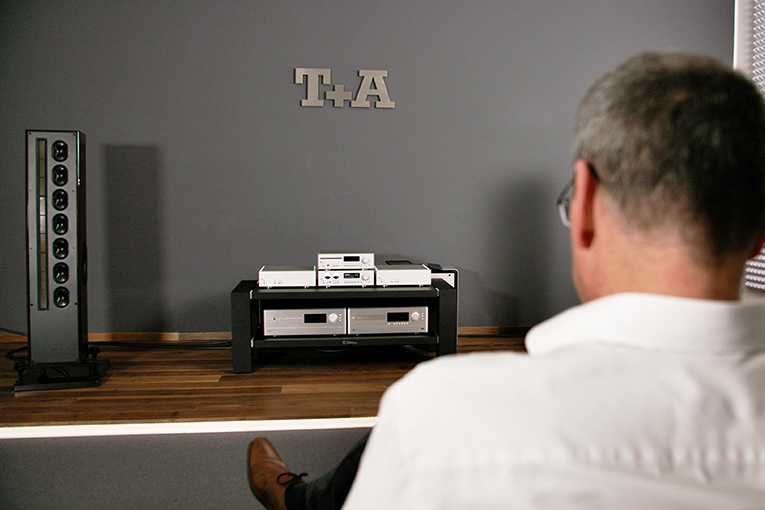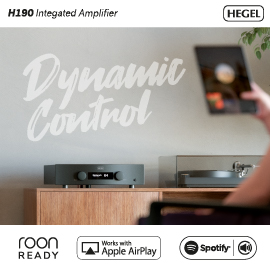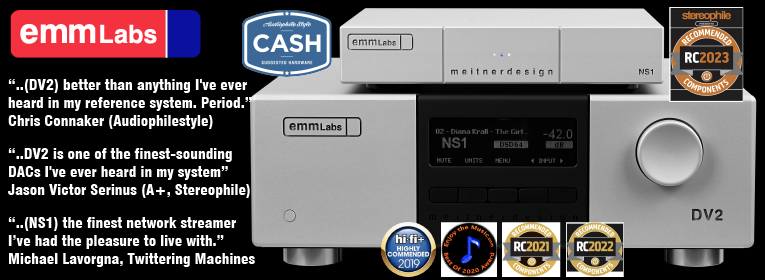In 2022, I traveled to more countries to visit more hi-fi companies and hi-fi shows than in any previous year. I went to the Netherlands and England twice, three times to Germany, once to Poland, all the way across Canada, and to several places in the United States. In doing so, my purported “standing” with a couple travel-related companies blossomed—I regained Silver Elite status on Air Canada, and achieved Gold Elite status at Marriott for the first time.
But when George Clooney’s Ryan Bingham, in the film Up in the Air, finally racked up ten million frequent-flyer miles, he found that attaining such statuses sounds better than it actually is. The titles these companies give you are basically their way of making you feel good about all the money you’ve spent with them—and often the gifts and perks they offer don’t amount to much. But I don’t really mind, because, unlike some people I know, I never complain about traveling for business—I love seeing different parts of the world and meeting the people who live and work there. And when it comes to hi-fi, I always enjoy discovering something new. To me, these statuses are signs that I’ve learned a lot.

My final trip of 2022 was at the end of November. I first flew with videographers Chris Chitaroni and Jeremy Prudhomme to the Netherlands, where we boarded a train to Herford, Germany: the home of T+A. It was our second visit there in 2022. After we finished at T+A, we headed over to England to visit Bowers & Wilkins for the first time. But it was in Germany that I got to discover and experience T+A’s new Solitaire line of speakers, comprising the S 430, S 530, and S 540 models, which sell in the United States for $29,900, $44,900, and $54,900 per pair, respectively.
 Chris Chitaroni shooting the S 430, S 530, and S 540
Chris Chitaroni shooting the S 430, S 530, and S 540
We went to the T+A factory specifically to create a couple of videos about these speakers, which you can now find on our YouTube channel. One video outlines the configurations of the different models, while the other focuses more on the tech used for the midrange and high-frequency drivers. But we had a little extra time for listening, so I auditioned a pair of S 430s, and then we all heard a pair of S 530s. Unfortunately, we didn’t have time to hear the S 540, but what we heard from the other two models was impressive—and that’s what this article is mostly about.
Tech
The S 430 is the most conventional speaker of the three, though it has design wrinkles that make it distinctive. It’s a three-way design with two 8.7″ woofers toward the bottom of the front baffle. Above the woofers are two 5.5″ midranges, vertically flanking a newly developed Mag50 magnetostatic tweeter. The way the midranges and tweeter are arranged is called MTM, for midrange-tweeter-midrange.
 Jeremy Prudhomme (far left) and Chris Chitaroni (far right) listening as T+A founder Siegfried Amft (second from left) and international sales director Oliver John explain the design and benefits of the Mag50 tweeter
Jeremy Prudhomme (far left) and Chris Chitaroni (far right) listening as T+A founder Siegfried Amft (second from left) and international sales director Oliver John explain the design and benefits of the Mag50 tweeter
The tweeter is called Mag50 because it’s 50mm (about 2″) in length. But while some might be tempted to call it a ribbon tweeter, it’s not really that. It’s not an electrostatic driver, either, which is what T+A used in its previous Solitaire models, but eschewed for this new series because of problems such drivers can have in humid and/or dusty environments. Instead, it’s a magnetostatic driver. With a magnetostatic design, bar magnets are placed above and/or below a thin diaphragm that has thin conductive strips bonded to it. T+A successfully used magnetostatic drivers in its Solitaire P and P-SE headphones, which were released a few years ago, then built on that experience to develop the tweeters for the Solitaire speaker line.
The S 530 and S 540 are much more radical-looking designs—so radical that they might get misunderstood by consumers not familiar with line-source or line-array speaker designs. But the concepts behind them aren’t new to T+A—these speakers are based on previous-generation Solitaire models but with some new design elements, including all-new drivers.
The S 530 and S 540 share the same line-source magnetostatic tweeter, dubbed Mag850, which is 850mm (about 33.5″) in length. While it’s much longer than the 50mm driver used in the S 430, it’s the same width, at 25mm (1″). The additional length means two main things. First, the surface area is increased, so it can move a lot more air and therefore generate higher output levels: 120dB at 2 meters, according to T+A founder Siegfried Amft, which would be deafening if you listened for too long. Secondly, it acts as a line source, as opposed to the shorter Mag50, which is more of a point source, like a traditional dome tweeter.
 Siegfried Amft explaining the Mag850 tweeter to Chris and Jeremy, with T+A transducer engineer Sebastian Kobelt looking on
Siegfried Amft explaining the Mag850 tweeter to Chris and Jeremy, with T+A transducer engineer Sebastian Kobelt looking on
Unlike a point-source driver, which tends to radiate sound pretty evenly in all directions, the output from a line source is focused in front of the driver—where the listener is—as well as toward the sides. Above and below the diaphragm, however, the sound energy drops off sharply. So think of it as a vertically aligned beam of sound. Horizontal dispersion is good, but vertical dispersion is limited, which means that floor and ceiling reflections are greatly reduced. Why can that be advantageous? We’ll come to that.
To complement the Mag850, the S 530 and S 540 both use a vertical array of seven oval midrange drivers, unlike the previous Solitaires, which had a vertical alignment of conventional round drivers. The T+A designers wanted them to be narrower this time, for better horizontal dispersion, hence the oval shape. These midranges, which looked to me to be about 4″ in height and 2.5″ across, act as a line array. They also focus most of their energy to the front, toward the listener, and disperse less energy above and below the driver array. So from the mids up through the treble, floor and ceiling reflections are greatly reduced.
 S 530 and S 540 midranges
S 530 and S 540 midranges
For the bass, the S 530 and S 540 both use side-firing 8.7″ woofers. The S 530 has just two of them, whereas the S 540’s larger cabinet can accommodate a total of four, two per side. The S 540 can deliver a deeper and more powerful bass, and the choice between the two floorstanders has mostly to do with the size of the room the speakers will be used in.
The thing about bass is that because the wavelengths are so long, dispersion is nearly impossible to control the way it is with the much shorter wavelengths of the midrange and treble frequencies. As a result, the bass output from all the Solitaires radiates pretty much omnidirectionally, like it does with traditional speakers.
S 430 listening
T+A international sales director Oliver John demoed the S 430 for me. The electronics were from T+A’s 200-series product line, not the company’s top-of-the-line HV gear. Music was streamed from Tidal, so he let me choose what I wanted to hear.
Right off the bat, I picked Greg Keelor’s “No Landing (Lucknow),” from his album Gone, and the Tragically Hip’s “Long Time Running,” from the 30th-anniversary remastered version of the band’s Road Apples. After he’d heard those two tracks, I saw John mark them in his playlist, because he had loved what he heard—musically and sonically.
 The Solitaire S 430s
The Solitaire S 430s
To say I was surprised by what I’d heard from the S 430s is an understatement—I was shocked. That’s because I’ve listened to many MTM-configured speakers over the years and almost always experienced severe vertical-directivity errors: odd tonal shifts the moment that your head moves out of the vise-grip sweet spot in the central listening position. I can’t stand that. There have only rarely been exceptions to this rule—and the S 430 is one of them.
While I still had to keep my ears more or less at tweeter height, there were no drastic sound changes when I stood up or crouched down—only a subtle diminishing of the high frequencies. Off to either side, the sound didn’t change much, either. The sound projected wasn’t much different from what you get with a traditional speaker setup where you have, say, a dome tweeter above a midrange and a woofer or two (or three) below. However, there was the subtle high-frequency rolloff I had noticed when my ears were too high or too low, so that is a bit of a difference.
But what was very unlike a conventional loudspeaker was the startling clarity across the entire audioband. I also admired the powerful nature of the bass and lower midrange—at the part when Johnny Fay’s drums kick in on “Long Time Running,” it sounded exactly like it should, like a real drummer striking the drumheads hard—and the effortlessness of the highs through to the bass. That effortlessness and clarity, which Amft attributes to the magnetostatic tweeter and the use of multiple drivers for the midrange and bass, was displayed in full force with “No Landing (Lucknow).” The reason I use this song is that when it’s cranked up loud and the equipment reproducing the sound can deliver what’s on the recording cleanly enough, it actually sounds like Keelor is right there in the room, singing as loudly as he can. The S 430s delivered that lifelike sound in spades—full-bodied, room-filling, and clear, without a hint of strain.
 The Mag50 diaphragm
The Mag50 diaphragm
Image specificity was good, too, though not quite to the level of the imaging of the S 530s, as I would discover. Keelor’s singing voice hovered solidly in the center of the stage, without wavering to either side. Ditto for the imaging on “Long Time Running.” In that song, Gord Downie’s lead vocal is centered, Rob Baker’s guitar is way off to the right, and when Fay’s drums come in, they’re left and to the back—and that’s exactly what the S 430s delivered. I remember leaning back and saying: “Wow!”
John then played some more tracks that he selected. When those songs finished, it ran through my mind that the S 430s could be the first MTM-configured speakers I’ve heard in a long time—maybe ever—that I think I could live with. But I’d have to live with them for a bit to really know for sure. Still, what I heard knocked me out.
S 530 listening
After listening to the S 430s, I had to leave the room to finish up our video work with Chris and Jeremy, so Oliver John told me he’d get the S 530s set up in the meantime so I could listen to them next. It was at least two hours later when I came back, and since we were done shooting I had Chris and Jeremy in tow.
With three of us listening, plus John, we swapped positions in the room often, so each of us could get into the center position. John played some tracks, but then I had him play “No Landing (Lucknow)” again and was riveted by the presentation of Keelor’s voice. It was easily as clear as what I had heard through the S 430s, but now it was more starkly defined on the soundstage, and details of his voice, the accompanying instruments, and the acoustic space were more apparent. It could be played even louder than with the S 430s—way louder than I’d play it at home—and still with no sense of strain. But we also listened quietly, and the speakers sounded just as detailed.
 The Solitaire S 530s showcased
The Solitaire S 530s showcased
With “Long Time Running,” I heard a similar thing. Downie’s voice sounded remarkably clear, as well as better defined than I had heard through the S 430s; and Baker’s guitar was captivating for its extreme clarity and strict placement on the soundstage. But before Fay’s drums came in, I moved from the center seat and told Chris to sit in the middle. I could see his eyes go wide because of what he heard—and when the track completed, he reached out his hand in front of him, with his fingers curled like he was grasping a softball, and said: “It was like his voice was right there. Like there.” Yes, the imaging was that precise and that holographic—which was why I wanted Chris to be in the center to experience it.
That’s the thing about line-array and/or line-source speakers (the S 530 and S 540 are both)—they focus the sound more in front of the speaker, but not toward the ceiling and the floor, and with those reflections reduced, clarity increases immensely. Consequently, you can hear the music more clearly, details emerge more easily, and the soundstage usually has increased image specificity. That’s also why large electrostatic panels can sound so good—they, too, have limited floor and ceiling interactions.
 An S 530 under construction
An S 530 under construction
The downside of a speaker like the S 530 that focuses the sound mostly to the front and within a limited vertical window is that higher frequencies drop off drastically when your ears get above or below the driver(s)—way more than with a traditional speaker, and way more than I had heard with the S 430. To demonstrate that effect, we replayed some songs and I told Chris and Jeremy to stand up when I did. Chris was the first to say that the highs were gone the first time we stood up. That’s why you have to be sitting down and in the center to really enjoy a pair of S 530s or S 540s—which makes me wonder if that’s the reason this series is called Solitaire, because it’s best suited for one person listening alone. But when you’re sitting down, the sound is more detailed, focused, and visceral than with traditional loudspeakers—like way more. I happen to like that kind of sound—immediate, detailed, and hyperrealistic, so I can hear every nuance of the music—so I could easily live with a pair of S 530s. In fact, I want a pair.
To be reviewed?
What I have written here should not be construed as a formal review. Our reviews are always done in a reviewer’s home, in a familiar room with associated components that are also familiar. However, I left the T+A factory deeply impressed by what I had heard from the S 430 and S 530 loudspeakers, and wanted to convey that to our readers in a timely way. Under normal circumstances, I would’ve immediately followed up my visit with a request to review at least one of the models, but because I foresee my travel schedule being even more hectic this year than last, reviewing a pair of these speakers—or reviewing much of anything—might not be in the cards, at least for me.

All is not lost, mind you. We have other writers within the SoundStage! Network, and should a pair of Solitaires become available for review, I’m hoping that someone on our team will fill in for me and take them on. So stay tuned to our network of websites for a possible review in the future. But in the meantime, seek out the new Solitaire models if what I’ve described has piqued your interest. Of all the speakers I have heard this year, the S 430 and S 530 impressed me the most—and I’m certain they’ll impress many audiophiles looking for vividly detailed and ultraclear sound.
. . . Doug Schneider
das@soundstagenetwork.com






















